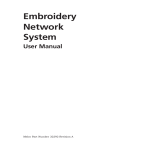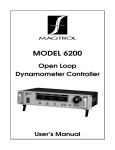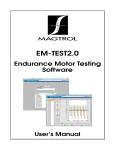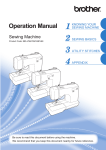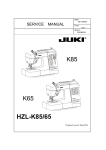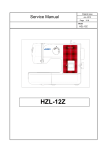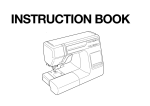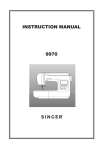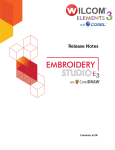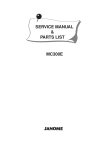Download JANOME MC9000 Memory Craft Service Manual
Transcript
SERVICING MANUAL 1 TABLE OF CONTENTS To change the face plate and top cover .................................................................................. 3 To change the belt cover unit ................................................................................................... 4 To change the bed cover unit .................................................................................................. 5 To change the base unit........................................................................................................... 6 To adjust the needle position ................................................................................................... 7 To adjust the needle bar height ............................................................................................... 8 To adjust the hook timing ......................................................................................................... 9 To adjust the upper shaft shield plate position ...................................................................... 10 To adjust the needle thread tension ....................................................................................... 11 To adjust the tension release mechanism for knee lifter ....................................................... 12 To change the threader plate and adjustment ....................................................................... 13 To change front panel (“a” board unit) 1 ................................................................................ 14 To change printed circuit board (“a” board unit) 2 ................................................................. 15 Drawing for “a” board connectors (front panel complete unit) ............................................... 16 To change board c and fuse .................................................................................................. 17 To change dc motor and belt tension adjustment .................................................................. 18 To change the transformer ..................................................................................................... 19 To change the receptacle (machine socket unit) ................................................................... 20 To change the LCD unit ......................................................................................................... 21 To adjust presser foot sensor (1) ........................................................................................... 22 To adjust presser foot sensor (2) ........................................................................................... 23 To adjust bobbin thread sensor ............................................................................................. 24 To replace the presser bar sensor to remove ........................................................................ 25 To adjust the buttonhole lever ................................................................................................ 26 To change the buttonhole lever (unit) to remove ................................................................... 27 To change buttonhole sensor unit to remove ........................................................................ 28 To adjust the feed dog up/down function ............................................................................... 29 To adjust the knee lifter position ............................................................................................ 30 2 TO CHANGE THE FACE PLATE UNIT AND TOP COVER UNIT FACE PLATE UNIT TO REMOVE 1. Remove the two screws, and remove the face plate. TO ATTACH 2. Tighten the two screws slightly, and attach the face plate. 3. Close the face plate, and check the unevenness between The face plate and arm. Tighten the screws securely. 4. Check if the face plate opens and closed smoothly. Adjust the position of the face plate spring if necessary. TOP COVER UNIT TO REMOVE 1. Remove the two screws A and raise the handle. Then remove screw B. 2. Close the top cover and raise the handle. Then pull out the top cover unit in the direction of the arrow. TO ATTACH 3. Raise the handle and insert the top cover unit from the rear side. 4. Attach the top cover unit by tightening the two screws A and B. 3 TO CHANGE THE BELT COVER UNIT TO REMOVE 1. Loosen the screw A and remove screws B, C and the washer. 2. Loosen the screw D completely, and remove the belt cover unit. TO ATTACH 3. Insert the belt cover in the front panel. 4. Replace screws A, B. C (with washer) and screw D. 4 TO CHANGE THE BED COVER UNIT TO REMOVE 1. Remove the base cover (see page 6). 2. Remove the two screws A, and remove the base lid. 3. Remove the two screws B, and remove the bed cover unit. Then pull out the connectors from the connector supporter and disconnect them. TO ATTACH 4. Follow the above procedure in reverse. NOTE: Set the drop lever as shown below. Make sure that you connect the plug before replacing the bed cover. 5 TO CHANGE THE BASE UNIT TO REMOVE 1. Remove the base cover. 2. Pull the connectors for the X-axis and Y-axis motors from “A” board. 3. Remove the 4 screws and the base unit. TO ATTACH 4. Follow the above procedure in reverse. Check the position of feed dog “UP and DOWN”. NOTE: 1) 2) Set The base unit that the right side of knee lifter link (4) claw should match the knee lifter plate on the base unit (see page 30). The carriage plate (unit) is not included the base unit (see page 29). 6 TO ADJUST THE NEEDLE POSITION When straight stitch #2 is selected, the needle should be at the center hole of the needle plate. When the zigzag stitch is selected with the zigzag width set to the maximum (7.0), the clearance between the side of the needle and the outer edges of the left and right needle plate holes should be 0.2 mm or more. 1. 2. 3. 4. 5. Remove the top cover unit. Select straight stitch #1, and turn the hand wheel toward you to bring the needle bar to the lowest position (see page 8). Loosen the setscrew, and move the zigzag rod left or right to set the needle at the center of hole of the needle plate. Then tighten the setscrew. Select the zigzag stitch #8, and set the zigzag width to the maximum (7.0). Turn the hand wheel toward you, and check if the clearance between the side of the needle and the edge of hole of the needle plate at the left and right needle position is 0.2 mm or more. Attach the top cover unit (see page 3). 7 TO ADJUST THE NEEDLE BAR HEIGHT The needle bar height means the distance between the upper edge of the point of hook and the upper edge of the needle eye when the point of the hook meets the right side of the needle in the upward travel of the needle bar from the lowest position with stitch pattern #2 ( ) selected. The standard needle bar height is 1.8±0.2 mm. 1. 2. 3. 4. 5. 6. 7. 8. Remove the needle plate and bobbin holder. Turn on the power switch and select stitch pattern #2 ( ). Press stitch length/ stitch width key ( ) and set the needle position to 0.0 on the touch panel. Turn the hand wheel toward you until the point of the hook meets the right side of the needle. Insert a hexagonal screwdriver through the work hole in the front bracket, and loosen the setscrew with it. Move the needle bar up and down to adjust its height. Tighten the setscrew, placing the needle setting groove of the needle bar on the front. Make sure that the point of the needle does not hit with the bottom of the hook race, when turning the hand wheel. Insert the bobbin holder and attach the needle plate. 8 TO ADJUST THE HOOK TIMING When pattern #2 ( ) is selected, the amount of ascending travel of the needle bar from its lowest position to the position where the tip of the rotary hook exactly meets the right side of the needle should be 3.25 to 3.55 mm. 1. 2. 3. 4. 5. 6. 7. 8. Remove the belt cover, bed cover, base cover and base lid (see page 4, 5, 6). Turn on the power switch and select pattern #2 ( ). Press the STITCH LENGTH / STITCH WIDTH key ( ) and set the needle position to 0.0 on the touch panel. Turn the hand wheel toward you, and set the needle bar to the lowest position. In this condition: • If the setting mark on the feed lift cam is right under the center of the lower shaft (Fig. 1), loosen the two setscrews on the lower shaft gear (Fig. 2). • If the setting mark is not right under it, loosen the two setscrews on the lower shaft timing gear (Fig. 3). Raise the needle bar 3.4 (± 0.15 mm) from the lowest position. Turn the lower shaft gear until the point of the hook meets with the right side of the needle, and tighten the two set screws on the lower shaft gear or the lower shaft timing gear. Attach the belt cover, bed cover, base cover and base lid (see page 4, 5, 6). 9 TO ADJUST THE UPPER SHAFT SHIELD PLATE POSITION NOTE: When the machine is set for zigzag stitching, the needle should start to swing 7.0 to 8.2 mm above the surface of the needle plate. 1. 2. 3. 4. 5. Remove the top cover unit. Turn on the power switch. Then select zigzag pattern #8 (see page 8). Turn the hand wheel toward you slowly with your hand until the needle starts to swing. (A) If higher than 8.2 mm, loosen the setscrew and turn the upper shaft shield plate in direction A. (B) If lower than 7.0 mm, loosen the setscrew and turn the upper shaft shield plate in direction B. Push the upper shaft shield plate as far as possible to the left. (It should not touch the upper shaft sensor.) Then tighten the setscrew. Turn the hand wheel toward you, and check the start point of needle swing. Attach the top cover unit (see page 3). 10 TO ADJUST THE NEEDLE THREAD TENSION 1. 2. 3. Turn on the power switch, select the pattern #9 ( ) and press the S/S key to turn the hand wheel 2 to 3 rotations. Open the face plate and adjust the thread tension with a screwdriver in the direction of: A to looser the tension. B to tighter the tension. Close the face plate. NOTE: Check that the auto-tension is set ‘AUTO” when “ADJ” key is pressed on the touch panel. 11 TO ADJUST THE TENSION RELEASE MECHANISM FOR KNEE LIFTER When the presser foot lifter is raised, the tension disc supporter should move by approx. 0.8 mm before adjusting the tension release mechanism for the knee lifter. 1. 2. 3. 4. 5. Remove the top cover unit (see page 3). Lower the presser foot lifter, raise the needle bar to its highest position, attach the foot (A) and lower the presser foot. (Make sure the feed dog is at the highest position.) Loosen screw. Adjust the clearance between the thread releasing lever and pressure drive arm to between 0.01 - 0.80 mm. Attach the top cover unit. 12 TO CHANGE THE THREADER PLATE AND ADJUSTMENT TO REMOVE 1. Raise the needle to its highest position and lower the threader knob to its lowest position. 2. Loosen the screw and remove the threader plate. (Fig. 1) TO ADJUST NOTE: Use #11 needle to adjust the threader plate position. 3. 4. If the hook of the threader plate touches left or right side, loosen the screw and adjust the hook position. (Fig. 2) If the hook of the threader plate touches the top or bottom side of the needle hole, loosen the screw and adjust the hook position. (Fig. 3) 13 TO CHANGE FRONT PANEL (“A” BOARD UNIT) 1 TO REMOVE 1. Remove top cover, belt cover and bed cover (see page 3, 4, 5), 2. Disconnect the LCD connector from inverter and remove it from cord guide. 3. Remove screw A and loosen screws B, C, D. 4. Pull out 17 connectors form the printed circuit board (“A” board) and printed circuit board (“F” board). Remove the front cover unit. NOTE: Pull out the LCD connector at the beginning to prevent damages. TO ATTACH 5. Follow the above procedure in reverse. NOTE: After attaching the front cover (“A” board unit), shift the bobbin winder spindle to check the micro switch movement. 14 TO CHANGE PRINTED CIRCUIT BOARD (“A” BOARD UNIT) 2 TO REMOVE 1. Remove front panel (see page 14). 2. Disconnect the LCD and the touch panel flat cable and “F” board connector from “A” board unit. 3. Remove 6 screws to disconnect the printed circuit board “A” and card guide. TO ATTACH 4. Insert the card guide boss to the rounded hole of card connector until connected. Then attach to “A” board. 5. Attach the printed circuit board “A” with 6 screws and insert the 2 flat cables to the connector, then push down the clamp. (Make sure the inject button should be positioned at the front cover hole.) 6. Connect “F” board. 7. Attach the front panel unit. NOTE: Adjust the (adjustment of touch panel) when the printed circuit board “A” is changed. Do not touch the connecting part of the flat cable with your finger: LCD flat cable should be inserted between the “A board unit and LCD board as shown below. 15 DRAWING FOR “A” BOARD CONNECTORS (FRONT PANEL COMPLETE UNIT) A B C D E F G H I J K L M Buttonhole sensor Pressure sensor Thread tension sensor LCD module Position sensor Inverter Bobbin thread sensor Feed dog up/down switch Lamp switch Bobbin thread detector solenoid Printed circuit board C Receptacle (Machine socket unit) DC motor N O P Q R Thread tension stepping motor Zigzag width stepping motor Feed stepping motor X axis stepping motor for embroidery Y axis stepping motor for embroidery TO CHANGE BOARD C AND FUSE TO REMOVE 1. Remove the base unit and slide the base (see page 6). 2. Loosen the three setscrews. 3. Unplug the 4 connectors. 16 TO ATTACH 4. Follow the above procedure in reverse. 5. Attach the base unit. (Check the feed dog up/down position with “ADJ” key after attaching the base unit.) TO CHANGE THE FUSE 6. After remove the board “C” case unit, remove two setscrews to pull out the printed circuit board “C”. 7. Replace the fuse in the fuse holder on board “C”. • If Fuse Fl (125V-2.SA) is blown ......... transformer or board “C” is damaged. • If Fuse F2 (250V-3.OA) is blown ........ too much power on the DC motor when the upper shaft, lower shaft or hook race is tight. 17 TO CHANGE DC MOTOR AND BELT TENSION ADJUSTMENT TO REMOVE 1. Remove the belt cover (see page 4). 2. Pull out the plug connector from “A” board unit and remove 2 screws. Then remove the lamp switch fixing plate. 3. Pull out the motor connector from “A” board unit and remove 2 screws. Then remove the DC motor unit. TO ATTACH 4. Pass the motor cord under the arm lib, then attach the motor with 2 screws temporary as shown below, 5. Set the motor unit with the motor belt. Make sure the belt tension should be set as shown below. 6. Attach the lamp switch fixing plate with 2 screws. 7. Insert the connectors to the “A” board unit. 8. Attach the belt cover. 18 TO CHANGE THE TRANSFORMER TO REMOVE 1. Remove the front panel (board A unit) (see page 14). 2. Remove the cord guide (see page 7) and the DC motor (see page 18). 3. Remove two connectors of transformer from C board case unit. 4. Remove the three screws and pull out the transformer. TO ATTACH 5. Follow the above procedure in reverse. 19 TO CHANGE THE RECEPTACLE (MACHINE SOCKET UNIT) TO REMOVE 1. Remove the belt cover (see page 4). 2. Cut the cord binder. 3. Pull out the connectors from board A unit and board “C” case unit. 4. Remove two set screws and change the receptacle (machine socket unit). TO ATTACH 5. Follow the above procedure in reverse. 20 TO CHANGE THE LCD UNIT TO REMOVE 1. Remove the front cover (board “A”) (see page 14, 15). 2. Loosen two screws A and remove A board fixing plate. 3. Loosen four screws B and remove the LCD frame unit. TO ATTACH 4. Follow the above procedure in reverse. NOTE: Check the adjustment of touch panel when LCD frame unit is replaced. 21 TO ADJUST PRESSER FOOT SENSOR (1) 1. 2. 3. 4. 5. 6. Enter adjustment mode: (Turn the power switch on while pressing the S/S key and the reverse key. Next, press needle stop key within two seconds, then press the needle stop key again.) Attach presser foot “A” and set the pressure dial at “3” Lower the presser foot. Turn the hand wheel toward you to bring the needle bar to its lowest position. Loosen the screw on the presser bar shielding plate. Shift the presser bar shielding plate all the way to the right. LCD shows “OPEN.” Rotate the shielding plate slowly. When the LCD says “CLOSED,” Then rotate it a further 0.5 - 1 mm to the left. Tighten the screw. Check The LCD indication when the presser foot shielding plate is moved along the free play. • If LCD shows “CLOSED” only check step 7 • If LCD shows “OPEN” only adjust the presser bar height for embroidery foot “P.” Then, repeat steps 1-6. 22 TO ADJUST PRESSER FOOT SENSOR (2) 7. 8. 9. 10. Set the presser dial at “2.” Aft ach embroidery foot “P” and lower the presser foot slowly. Turn the hand wheel toward you to bring the needle bar to its highest position. Watch The LCD screen while moving the shielding plate along the free play. LCD shows: OPEN only correctly adjusted. Turn the power off to exit adjusting mode. CLOSED Adjust the presser bar height with the embroidery foot and repeat steps 1-6 again. NOTE: Lower the presser foot and turn the hand wheel while the needle position is at highest, lowest and highest needle position, in this condition The LCD indication should be shown “OPEN.” If LCD changes from “OPEN” to “CLOSED,” adjust the presser foot height with the embroidery foot “P,” and repeat 1-6 adjustment. 23 TO ADJUST BOBBIN THREAD SENSOR NOTE: Insert the bobbin to the bobbin holder without bobbin Thread. When you check the bobbin thread sensor adjusting mode. (Press S/S key and reverse stitch key together while turning the power switch, Then press The auto-look key and S/S key next with in a few seconds. After This procedure, the touch panel (LCD) indicates numbers to adjust bobbin thread sensor as step 1-13.) 1. 2. 3. 4. Remove the base unit (see page 6). Loosen screws A (2), B (1). Insert the pacer between the change position arm and driving arm. Insert the empty thread bobbin to the bobbin holder, and pull the change position arm to the right side A shown below. (200 - 300 g) 5. Buffs the bobbin holder unit to the bobbin holder topper at the left side. (Fig. 1) 6. Tighten screws (2) (do not hold The solenoid with your hand). 7. Buffs the convex of shielding plate to the left side of sensor. At This time do not push the sensor rod. 8. Tighten screw B. 9. Aft ach the base unit. (After the above adjustment, make sure the touch panel shows 10 when you check the bobbin thread sensor adjusting mode.) NOTE: Press needle UP/DOWN key and bobbin Thread key to check the following steps. 1. 2. Insert the bobbin (9.2mm in diameter or gauge) into bobbin holder and when press the bobbin thread key, touch panel indicates (The bobbin Thread almost out). Insert the bobbin (10.3mm in diameter or gauge) into bobbin holder and when press the bobbin thread key, touch panel indicates (sufficient bobbin thread). 24 TO REPLACE THE PRESSER BAR SENSOR TO REMOVE 1. 2. 3. Remove the top cover unit (see page 3). Remove the screw and the presser bar sensor. Unplug the presser bar sensor connector from the board “F”. Remove the cord from the cord guide and remove the sensor unit. TO ATTACH 4. Follow the above procedure in reverse. NOTE: • Make sure the sensor and shielding plate do not touch when rotating the shielding plate by hand. • After replacement, you must adjust the position of the sensor (see page 19, 20). 25 TO ADJUST THE BUTTONHOLE LEVER 1. 2. 3. 4. 5. 6. Enter adjusting mode. (Press the S/S key and the reverse key while turning the power switch on. Press the lock stitch key and needle up/down key within seconds.) The LCD screen shows “BH SENSOR START CLOSED.” Loosen screw “A” and move The BH lever guide. The LCD screen should show “OPEN” when The BH lever is raised and lowered. Attach the BH foot (R) and lower the BH lever. Put a 1.6 mm gauge in between the sliding part of the automatic buttonhole foot and its end, as shown. Loosen set screw “B.” Move the sensor plate from right to left. Tighten the screw just as The LCD screen shows “CLOSED.” Make sure The LCD still shows “CLOSED” when the BH foot “R” clearance is reduced to 1.4 mm and “OPEN” when the clearance is increased to 1.8 mm. NOTE: The LCD screen shows (1) CLOSED (2) OPEN (3) CLOSED when the sensor plate is moved from right to left on STEP 5. Adjustment should be set from (2) OPEN to (3) CLOSED position. 26 TO CHANGE THE BH LEVER (UNIT) TO REMOVE 1. 2. 3. Loosen screw and remove the BH shielding plate. Remove the snap ring. Pull out the BH lever unit. TO ATTACH 4. 5. Slide The BH lever unit (without BH shielding plate) onto the shaft as shown below and put the snap ring on the shaft. Attach the BH shielding plate with the screw. NOTE: Adjust the BH lever position after replacing it. 27 TO CHANGE BH SENSOR UNIT TO REMOVE 1. 2. 3. Remove the top cover unit (see page 3). Loosen the screw and remove the BH sensor from the sensor fixing plate. Pull out the BH sensor connector from board F and pull out the cord from the cord guide (1), (2). Then change the BH sensor unit. TO ATTACH 4. To attach the BH sensor, follow the above procedure in reverse. NOTE: • Make sure the BH sensor and shielding plate do not touch when attaching the BH sensor. • Readjust The BH lever after attaching the BH sensor unit (see page 27). 28 TO ADJUST THE FEED DOG UP/DOWN FUNCTION The feed dog drops automatically when selecting embroidery sewing and rises auto-matically when selecting normal stitches. 1. 2. 3. 4. 5. 6. Remove the carriage cover cap. (Pull the carriage away from the machine a little and pry off the cover cap with a screwdriver, as shown below.) Loosen the two screws. If the drop feed finger does not fit into the notch in the drop feed knob (when embroi-dery sewing is selected on The touch panel), slide the drop feed finger right or left until it goes in. Tighten the screws. Attach the carriage cover cap. Check the feed dog up/down position with the touch panel. (Use “ADY key func-tion.) 29 TO ADJUST THE KNEE LIFTER POSITION NOTE: Before adjusting the knee lifter position, check the presser bar height with foot P (embroidery foot) (see page 21). 1. 2. 3. 4. 5. 6. Remove the top cover and belt cover (see page 3, 4). Remove the receptacle unit (loosen screws and move the receptacle slightly away from original position). Lower the presser foot and set the needle bar at lowest position (the pressure con-necting arm should just touch on the cam). Loosen the nut and turn the adjusting screw. Adjust the clearance between the pressure connecting arm pin and the knee lifter link (5) to between 0.01 - 0.3 mm. Attach the receptacle. Attach the belt cover and top cover unit. 30 CHECK OPERATION If nothing happens when you turn on The power switch, turn off The power and wait 4-5 minute. Then turn on switch. DIAGNOSIS CHART STEPS TESTING OPERATION CORRECT CONDITION DEFECTIVE CONDITION & CORRECTION 01) BUZZER, LED TEST Turn on the power switch while pressing “REVERSE” key • Buzzer sounds (LCD shows buzzer & LED) • Red & green lights flash alternately on START/STOP key • No buzzer sounds and could not enter test mode • LED module shows program version. Also, program will be locked • LED lights or no lights on board • Replace board F • Replace board A 02) KEY TEST Push START/STOP key • “REVERSE” key • “AUTO-LOCK” key • NEEDLE “UP/DOWN” key LCD shows “PRESS S/S, REV, AL, U/D” • Buzzer sounds for next step. • No buzzer sounds and program will be locked • Replace board F • Replace board A 03) TOUCH PANEL TEST • Press “PRESS THIS KEY” on left side Press “PRESS THIS KEY” on right side • Buzzer sounds and indicates “PRESS THIS KEY” at right hand side on LCD board • Buzzer sounds for next step • No buzzer sounds and program will be locked • Replace touch panel • Replace board A LCD shows “SPOOL” • Buzzer sounds every time when bobbin winder spindle is shifted • No buzzer sound • Replace board A 05) FEED DOG UP/ • Shift the drop lever to LEFT LCD shows “FEED DOG” DOWN SWITCH • Buzzer sounds when drop lever RIGHT position KEY TEST position is changed • No buzzer sound • Replace feed dog switch • Replace board A 06) SPEED • Move the slide switch from SETTING SLIDE left to right SWITCH TEST • Move the slide switch from LCD shows “SLIDE SWITCH” • Buzzer sounds at left & right positions. • No buzzer sound • Replace slide switch • Replace board A LCD shows “CONTROLLER” • Buzzer sounds when foot controller is pressed fully and released • No buzzer sound • Replace foot controller • Replace board A LCD shows “FOOT LEVER” • Buzzer sounds when foot controller is depressed and released • No buzzer sound • Replace presser foot sensor • Replace board F • Replace board A 04) BOBBIN WINDER SWITCH TEST Press appointed key This key • Shift the bobbin winder spindle to LEFT & RIGHT position right to left. 07) FOOT CONTROLLER TEST • Press the foot controller fully and release it 08) PRESSER • Lower the presser bar lifter FOOT SENSOR • Raise the presser bar lifter TEST 09) BUTTONHOLE SENSOR TEST • Shift the BH lever back & forth gently LCD shows “BH SENSOR STATE” • When lever is pulled toward you buzzer sounds & indicates “CLOSED” on LCD board • When lever is released buzzer sounds & indicates “OPEN” on LCD board • No buzzer sound • Replace BH sensor • Replace board F • Replace board A 10) THE AMOUNT OF BOBBIN THREAD ENSOR TEST • Press “START/STOP” key LCD shows “SENSOR & SOLENOID” • Buzzer sounds and LCD shows “14” without bobbin • LCD shows “0” If LCD shows No.1 - 13, adjust The machine • Adjust bobbin thread sensor unit • Replace bobbin Thread sensor • Replace solenoid • Replace “A” board 11) UPPER SHAFT POSITIONING SENSOR TEST • Turn the hand wheel toward LCD shows “PH SENSOR” • LCD shows “BIGHP when needle is you to move the at highest position needle bar to highest position • LCD shows “FEED” when needle is at and lowest position lowest position • LCD does not show “BIGHT” or “FEED” Also LCD does not change indication vC’hile turning hand wheel * Replace upper shaft positioning sensor • Replace “A” board 12) STEPPING MOTORTEST • Raise the needle bar to highest position and push “START/STOP” key • Lower the needle bar to lowest position and push “START/STOP” key • Turn the hand wheel and check the feed dog position LCD shows “STEPPING MOTOR” • Stepping motor (zigzag) get default position • Feeding, tension motors get default position • Feed dog goes to home position • Not working correctly • Replace stepping motor • Replace tension sensor • Replace “A” board 13) MACHINE MOTOR TEST • Press START/STOP key LCD shows “DC MOTOR” • Machine runs slow, and fast, then needle bar stops at the highest position • Not stopping at the highest position or running at uneven speed • Replace DC motor • Replace “A” board 31
































